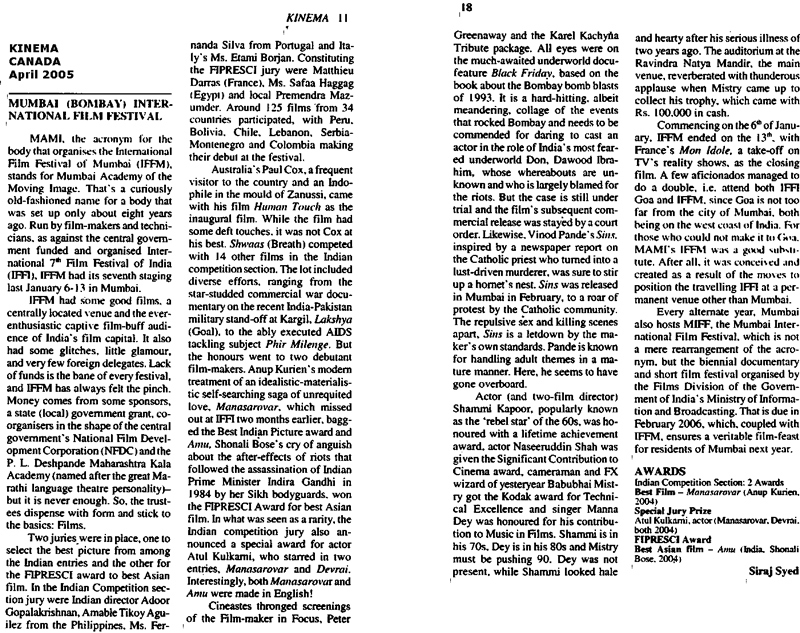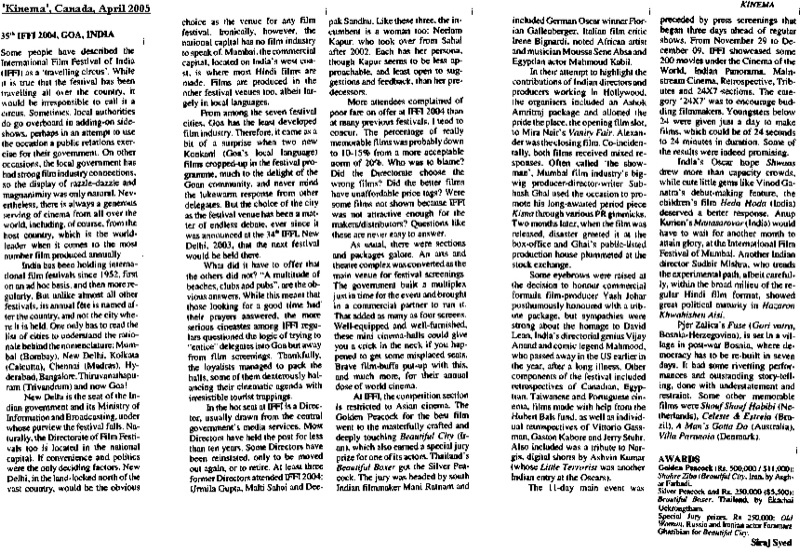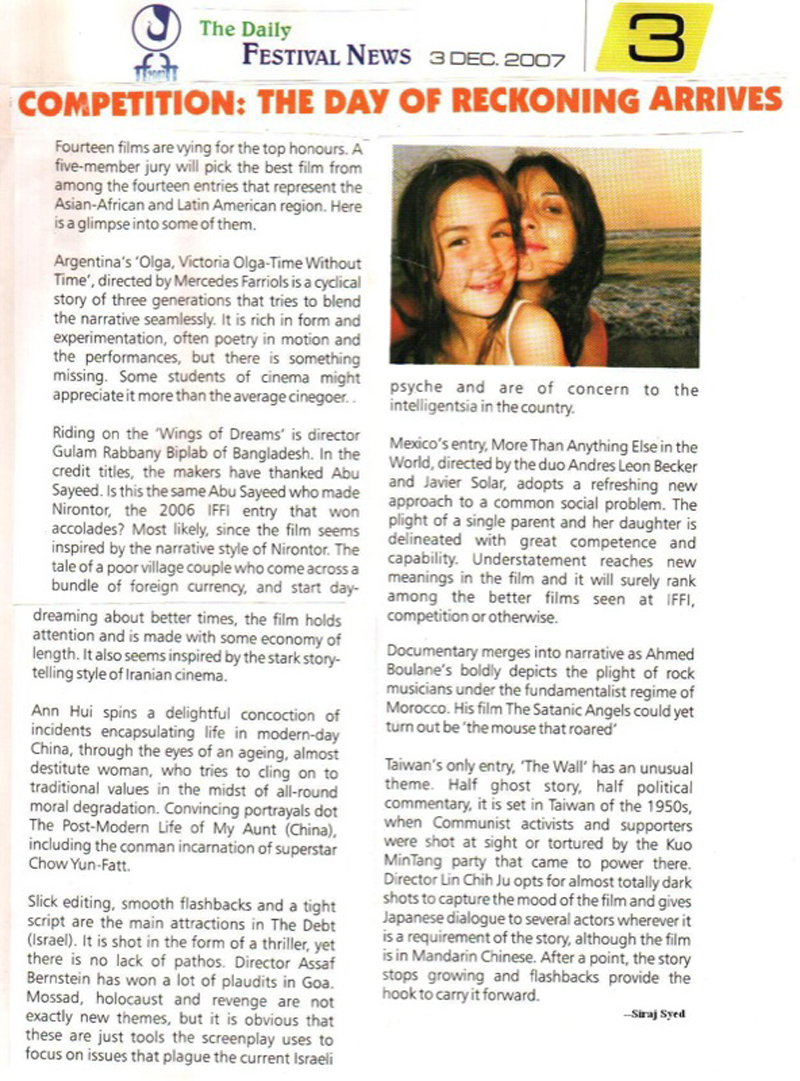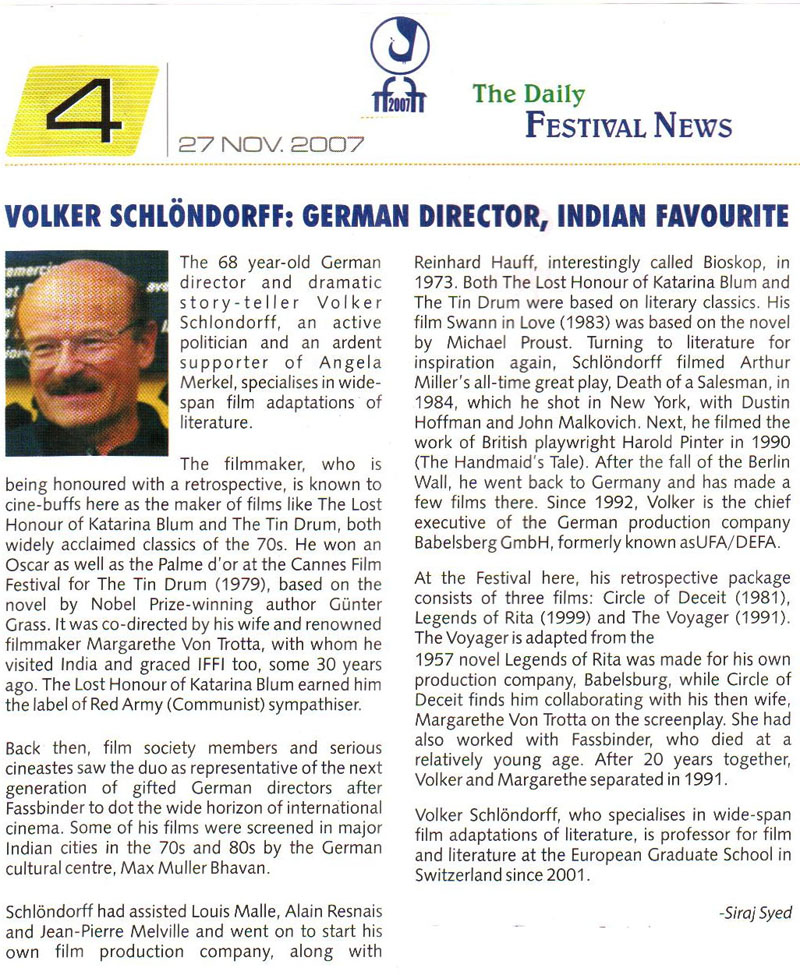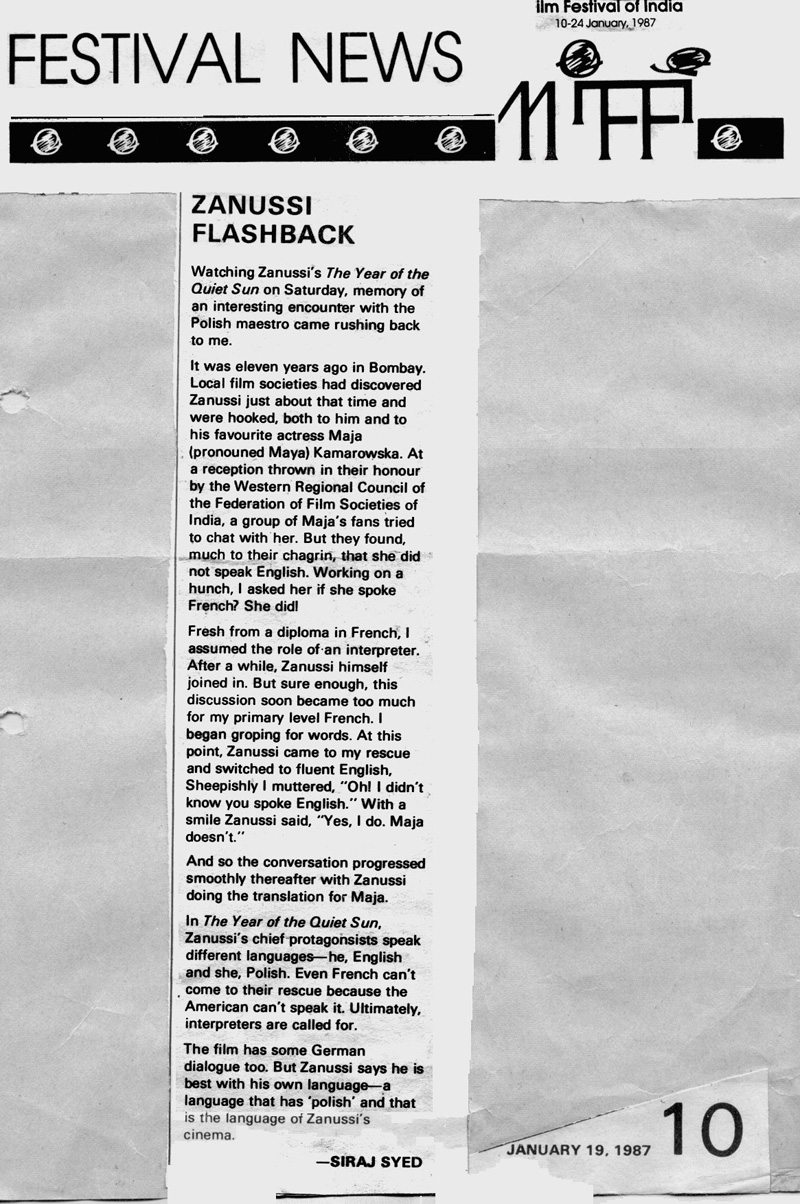|
|
||
|
Pro Tools
FILMFESTIVALS | 24/7 world wide coverageWelcome ! Enjoy the best of both worlds: Film & Festival News, exploring the best of the film festivals community. Launched in 1995, relentlessly connecting films to festivals, documenting and promoting festivals worldwide. We are currently working actively to upgrade this platform, sorry for the inconvenience. For collaboration, editorial contributions, or publicity, please send us an email here. User login |
Siraj SyedSiraj Syed is the India Correspondent for FilmFestivals.com and a member of FIPRESCI, the International Federation of Film Critics. He is a Film Festival Correspondent since 1976, Film-critic since 1969 and a Feature-writer since 1970. He is also an acting and dialogue coach. @SirajHSyed  Sye Raa Narasimha Reddy, Review: Per capita
Sye Raa Narasimha Reddy, Review: Per capita “This Gandhi Jayanti, India unites to fight,” declares a large card on the trailer of Sye Raa Narasimha Reddy. Mohandas Karamchand ‘Mahatma’ Gandhi (born 02 October 1869) was the father of the nation and an apostle of peace and non-violence. ‘Jayanti’(in Hindi) refers to his 150th birth anniversary, which is being celebrated with many campaigns across the country, like voluntary service to society, cleanliness and end to ‘one-time plastic’ usage. Welcome to the 02 October 2019 release of one of the most violent films ever seen in India, with blood flowing like water, in a land reputed to have milk flowing through its waterways, instead of H2O, in the olden days, of mythical yore. Since this film is granted a U/A certificate by the Central Board of Film Certification, which allows children above 12 to see the film when accompanied by adults, then, pray, what will qualify as fare suitable for an A certificate, for adults only (entry restricted to those above 18)? In fact, Sye Raa Narasimha Reddy should be shown only to hardened cinema-buffs, or even lay filmgoers, for that matter, who produce medical certificates that they are immune, or desensitised, enough, to watch blood-letting and decapitating, in large overdoses, lasting for about 170 minutes. For starters, in one battle alone, 13,000 men are butchered, to kingdom come. Some years before India's first war of independence (1857), Majjala Uyyalawada Narasimha Reddy (Chiranjeevi) is the ruler of Renadu, from the Rayalaseema region of present-day Andhra Pradesh, who lives happily, with his wife, Siddhamma (Nayanthara), his mother (Lakshmi Gopalaswamy) and with his devoted subjects. He was betrothed to Siddhamma, as a child-groom, to avoid a planetary curse, and did not even remember the ceremony, as an adult. Now about 30, he falls in love with dancer Lakshmi, and gives her his necklace as a token of engagement. He advises her to change her classical dancing routine to awaken the masses against the British oppressors, but she refuses, insisting that she will dance only for God and him. He promises to marry her, but the flashback of 24 years ago holds him back. Sometime earlier, the British East India Company, which had come to India for business, soon started torturing Indian people, and began to loot and ship Indian produce, like grains and cotton, back to their country. When Narasimha Reddy witnesses their atrocities, he gets furious and leaves his throne, wife and mother, to begin a crusade against the foreigners. He teams up with rulers of other neighbouring regions: Veera Reddy (Jagapathi Babu), Avuku Raju (Sudheep), Raja Pandi (Vijay Sethupathi), with the blessings of his Guru, Gosayi Venkanna (Amitabh Bachchan)--to start a rebellion against the British East India Company. They have cannons and guns, Reddy’s men have axes, lances, swords, bows and arrows. But Sye Raa is no ordinary mortal. He fights like the Narasimha avatar of God, who took birth on earth to destroy the arrogant king Hiranayakashyap(u). Writers by Paruchuri (twin) Brothers, Paruchuri Venkateswara Rao, elder and Paruchuri Gopala Krishna, who began their careers 41 years ago as dialogue writers, and director Surender Reddy (several Telugu films and two Hindi films: Kick and Kick 2; not an A-listed director yet in either language; screenplay) have joined hands on this project, which comes soon after the Paruchuris’ Rudrama Devi (Telugu), another period piece, on the queen of the Kakatiya dynasty, set in the 13th century. Asked about the factual content and cinematic licence of Narasimha Reddy, they told a publication last year, “We have definitely given the story a flourish, but the core is untouched.” It took a decade for the project to take-off, they reveal. “Every time we used to visit them (Chiranjeevi and family), we would talk about this story. I guess it has been going on for more than 10 years now.” Instead of dissecting form, let’s first talk about content. The film is based on a true story, and we have the makers’ word for that, though truth has rarely been so incredible, even in cinema, where disbelief is suspended to a large degree. India of 1847, or thereabouts, is the time frame, and that is faithfully reproduced, in terms of landscapes, sets and costumes. Since it is about rebellion against the invading British, is there freedom fighting in it? Yes. Freedom was gained 100 years later, but the fighting, if we go by the movie, began in right earnest, in 1847, a full ten years before what the British historians call the Sepoy Mutiny of 1857, and the Indian’s call the first uprising against British colonials. Is there romance in it? Yes, there is, and just about the right, moderate, dose. Is there religion in it? Plenty, ranging from the astrology dictated childhood nuptials of Narasimha, to the stipulation that the couple should not set eyes on each other for another 24 years, to his ritual of lighting of the lamp, the auspicious Karthikai Deepam, come what may, to the Muslim ruler (Mukesh Rishi) and his soldiers, who join hands with Narasimha. What about palace espionage? No worries. Our hero is an adopted son and his brother is a greedy bum. Moreover, one of his royalty partners is keen on usurping his lands, after eliminating him. Again, the son of another royal team-member betrays him. Action, religion, romance, palace espionage and intrigue. Now add to that a critical level of patriotism, so critical that Manoj Kumar (legendary Indian actor-writer-director, known as Mr. Bharat for his clutch of patriotic Hindi movies) would probably gape at with disbelief, and you have a formula that just has to work. Repeated thunderous applause, at a press and invitees screening, whenever ultra-nationalist dialogue was delivered, bore testimony to the fact that patriotism is staple food to Indian audiences, never mind the collateral damage. Logic is at a heavy discount. Whenever the hero is attacked, the adversaries approach him in ones and twos, well aware that it would take perhaps twenty to make any impact. Almost all the victims are twirled round the finger…er…in mid-air, by the protagonist, who himself takes the aerial route every few kills and pirouettes in mid-air. Facing cannons, fort guards stand along the high parapet walls, imitating sitting ducks. The hero lets the enemy eliminate few of his own retinue before grimacing and setting his plans of a counter-attack in motion. The British hunt high and low to get Narasimha, and keep sending different contingents, of varying head-counts, to do the needful. Yet, they are never ready or sensible enough to shower bullets or cannon-balls at him, when he is within striking distance. Three interesting plot points emerge amidst all this skulduggery: Reddy’s advice to Lakshmi to arouse the masses with her songs and dances instead of merely performing, him stopping her from committing suicide and giving his necklace to her as a promise of marriage, and his definition and explanation of what theft is, to a little boy, who has stolen food for his hungry mother, in a drought affected village. The mother sets fire to her own home, as penance and out of desperation, but the boy will later set into motion a high point in the story. Likewise, Lakshmi will rise to the occasion and prove that sublime love is beyond trivialities like life and death, with her dance and the necklace as symbols of ultimate sacrifice. For those who do not know, Konidela Siva Sankara Vara Prasad ‘Chiranjeevi’ is 64, though he plays a character that cannot be more than 30 years of age. Portly and bulky, with a full face and loaded with vestments and weapons, he still moves like quick-fire. But these days, both looks and movements can be manipulated beyond imagination. Amitabh Bachchan, now 77, is made to look 87, with such hirsute layers that, for the first few frames, you might be forbidden for thinking that he has dubbed the voice of the actor playing the seer, rather than playing him himself. With not much to do except strike a very religious pose and deliver the dialogue in his grainy baritone, he was not really necessary in the scheme of things. On the other hand, if you can afford 1,00,000 junior artistes, and 1,00,000 special effects, you can afford the immaculate Amitabh Bachchan too. Tamannaah, who is familiar with Telugu audiences with films like Oosaravelli, does a pretty decent job. A malleable face and intricate dance moves help her win the audience, and then the script raises her to a starry height. Nayanthara is good too, as is the support from Jagapathi Babu, Lakshmy Gopalaswamy, Vijay Sethupathi, Ravi Kishan, Sudheep, Mukesh Rishi. The fair-skinned…er…the Caucasian actors, all play British army-men and administrators, all up to no good, and almost all reduced to bits by the end of the film. They include Matthew Stirling as Daniel, Oskar Skagerberg, Terence J. Rotolo, Alex O’Nell, Daniel O’Kane, Henry Maynard, Mark Kitto, James Graeme, David Blazejko and Mark Rathbone. Songs written by Swanand Kirkire are set to music by Amit Trivedi (A. R. Rahman was initially approached, but had too many commitments to take on one more). Telugu being the key language, both Kirkire and Trivedi deserve sympathy while writing the Hindi songs and fitting them into the Telugu metre. Close-ups often betray the lack of lip-sync. Yet, the songs "Jaago Narsimha Jaago Re," singers Udit Narayan, Shankar Mahadevan, Shaan; "Sandal Meraa Mann," Abhijeet Srivastava, Shreya Ghoshal; "Sye Raa Title Track," Sunidhi Chauhan, Shreya Ghoshal and "Saansein Teri Desh," K.K., are palatable. Even more palatable is the background music score by Julius Packiam. Cinematography R. Rathnavelu does justice to the vast expanses of bare land, the soldier formations, the brood of covered wagons, the palace revelry and the horse-back battle scenes. Lens flares are used often, but they are such a utilitarian imperfection that nobody complains. Only an editor of the calibre of A. Sreekar Prasad could pace the film so evenly and make you sit through almost three hours without too much shifting in your seat. I am tempted to end this review on a lighter note, after that gruesome and ghastly dose of elaborate body-piercing. Throughout the film, the Englishmen talk to each other and the Indians in fluent Hindi, with an occasional trace of accent, even when they are shown to be in England. In one of those scenes, a higher official berates his junior for showing him only one side of the picture and reporting that 3,000 of Reddy’s men were killed in a battle, while concealing the fact that there were 10,000 casualties on the British side. Is such concealment even possible? Now for those who are wondering what does the headline of this review mean? What is ‘per capita’ doing, in a tale of India’s revolt against British imperialism? Capita literally means head, in Latin, and you will find many heads in Sye Raa Narasimha Reddy, some held high and some hung low. Some of them actually roll (not role). They are heads, only headso, with no bodies. Decapitated. Detached. Severed. Chopped-off. Headless wonders, anyone? Then there’s a ticket price to pay for seeing the film, and that too is paid per capita. Rating: ** 02.10.2019 | Siraj Syed's blog Cat. : 1857 A. Sreekar Prasad A.R. Rahman Alex O’Nell Amit Trivedi Amitabh Bachchan caucasian Central Board of Film Certification Chiranjeevi colonialism Daniel Daniel O’Kane David Blazejko decapitation Gopala Krishna gory gruesome Henry Maynard Jagapathi Babu Jagapathi Rao James Graeme Julius Packiam Konidela Siva Sankara Vara Prasad Lakshmy Gopalaswamy lens flares Majjala Uyyalawada Mark Kitto Mark Rathbone Matthew Stirling Mukesh Rishi Mukesh RishiBritish Narasimha Oskar Skagerberg Paruchuri Brothers R. Rathnavelu Ravi Kishan revolt Sudheep Surender Reddy Swanand Kirkire Tamannaah Terence J. Rotolo Vijay Sethupathi Independent FILM
|
LinksThe Bulletin Board > The Bulletin Board Blog Following News Interview with EFM (Berlin) Director
Interview with IFTA Chairman (AFM)
Interview with Cannes Marche du Film Director
Filmfestivals.com dailies live coverage from > Live from India
Useful links for the indies: > Big files transfer
+ SUBSCRIBE to the weekly Newsletter DealsUser imagesAbout Siraj Syed Syed Siraj Syed Siraj (Siraj Associates) Siraj Syed is a film-critic since 1970 and a Former President of the Freelance Film Journalists' Combine of India.He is the India Correspondent of FilmFestivals.com and a member of FIPRESCI, the international Federation of Film Critics, Munich, GermanySiraj Syed has contributed over 1,015 articles on cinema, international film festivals, conventions, exhibitions, etc., most recently, at IFFI (Goa), MIFF (Mumbai), MFF/MAMI (Mumbai) and CommunicAsia (Singapore). He often edits film festival daily bulletins.He is also an actor and a dubbing artiste. Further, he has been teaching media, acting and dubbing at over 30 institutes in India and Singapore, since 1984.View my profile Send me a message The EditorUser contributions |


















